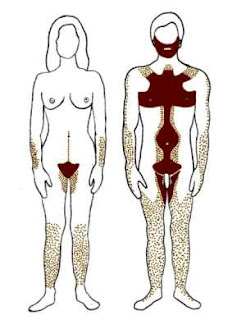
Scanning down the evolutionary tree, one can find semblances with our ancestors (naturally, as a part of the legacy). But there are instances when one can not explain certain things. For example, in humans we find hairs in the axillary areas (armpits), pubic areas which seem to defy logic, from an evolutionary perspective. Goats, lions or chimpanzees don't have them. Why in the first place did we need to have them or what is the purpose they serve, or couldn't have we done without them? We don't find any evolutionary parallel in the vertebrate kingdom (to the best of my knowledge).
One might say that the conversion of testosterone to dihydrotestoterone, in the said areas, by 5 alpha reductase, is the reason why they grow at those places. This DHT ( dihydrotestoterone) then combines with its receptor within the cytoplasm of the cells, and the receptor- ligand- combine translocate to the nucleus to exert their effects. My point is not that. I just want to know why, all of a sudden, humans needed to grow 'beard' at those odd places. I mean, what's so Darwinian about this?
One reason that seems to make sense is that those hairs at the intertriginous areas may help reduce friction while we move. But I am not sure, as it has not yet been documented. There are instances where there are excessive body hairs all over, hypertrichosis (a condition that could even be caused by the antihypertensive agent 'minoxidil') or hirsutism, where females produce excessive body or facial hairs. How heavily a woman is 'furred' could be determined by Ferriman Galway scale. Well these conditions do NOT have a predilection towards those key areas (that is, they are not axilla/pubis specific) and we can safely discard them as not being relevant here.
Body hairs may have some roles in heat regulation (erection of hair [known by various terms as: horripilation, goose-bumps, piloerection, cutis anserina etc. etc]---> increased depth of skin---> more insulation, provided by the subcutaneous tissue occupying this place). Body hairs could also provide superficial protection, or the maintenance of beneficial microbial flora, what purpose these intertriginous hairs serve is a mystery.
Another possible explanation is that, hairs being great thermal insulators (and electrical too), can prevent the heat of the adjacent thigh skin, to reach the testes. The testes are normally cooler than the core body temperature by about 2 degree centigrade. This way they may be doing great evolutionary service, by letting us procreate.
Can you shed some light on this thread?
No comments:
Post a Comment